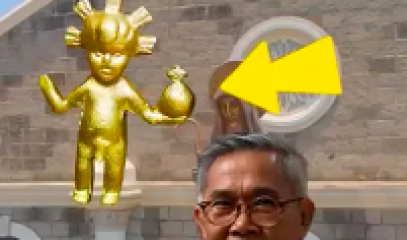AI used in Santo Niño de Cebu scam
Since September, a popular devotional figure has been used as part of an online scam, helped by the testimonial of a phoney priest, whose image appears to have been generated via artificial intelligence, the Rappler reports. In a video message, the archbishop of Cebu urges the faithful to be wary of fake accounts that claim to be associated with the Santo Niño shrine.
Manila (AsiaNews) – Philippine Catholics are very devoted to the statue of Santo Niño (the Christ Child), housed in the basilica of Cebu, which dates back more than 500 years and has accompanied the faith of the Philippine people for centuries.
According to tradition, Portuguese explorer Ferdinand Magellan gave the statue to Queen Juana of Cebu in 1521 after her conversion.
Every year, it attracts millions of pilgrims to the Minor Basilica of the Holy Child shrine, in particular, on the third Sunday of January, its feast day.
Over the past few weeks however, the image of an Infant Jesus has been posted online as part of a marketing campaign. Instead of being dressed in sumptuous robes like in the actual statue in Cebu, this one is naked (Santo Niño Hubad).
Phoney social media accounts claiming to be close to the diocese are offering figurines of the Naked Infant Jesus for a low price to bring “good luck" to the buyers.
In a statement, the Augustinian friars who oversee the Minor Basilica of Santo Niño de Cebu have warned the faithful that this is a scam, urging them not to be deceived by false advertising and not to buy Santo Niño Hubad statuettes.
The Archbishop Jose Palma of Cebu also posted a video message on Facebook, warning the faithful to be weary of a video promoting the lucky charm.
“I didn’t bless any naked Santo Niño,” the prelate says. And any other Facebook pages bearing the name of the basilica “is not in any way connected to the institution,” he added.
Already back in August, the Santo Niño shrine warned the faithful that solicitations in envelopes and electronic transactions using the name of the parish were a scam.
A quick check revealed that the priest in question does not exist. It is most likely that scammers, with criminal intent, used advanced technologies to create the phoney clergyman.
According to the Rappler, a Philippine online news website, a series of indicators suggest that artificial intelligence was used to create the image of the priest.
"In August,” the Rappler writes, “our business reporter Ralf Rivas even reported that a Japanese AI company launched a feature that can mimic the Filipino accent.”
Since it first appeared, “The post has generated over 40,000 reactions and was shared more than 1,500 times since its publication on Sept. 16.”
16/01/2023 12:10








.png)










